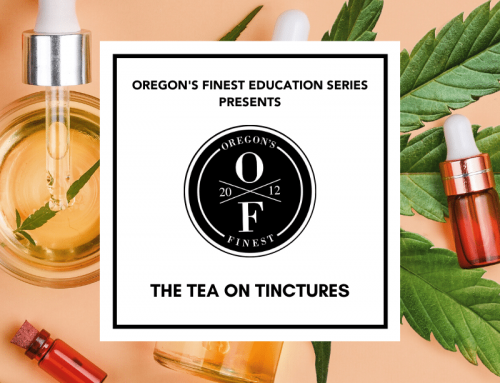By Garret Assistant Store Manager @ Oregon’s Finest in the Pearl
What do we picture when we think of growing cannabis? It’s likely that most of us have a mental image of outdoor plants growing from the soil, or indoor plants hanging out in pots, but what about hydroponic systems? Or soilless systems––what are the roots doing in there? How does a plant’s growing environment shape its actual growth? There’s a lot of growing going on outside of traditional soil, and each different method changes the character of the product we see and enjoy.
There’s much to consider here, but first, let’s understand why all of this is so important. Cannabis is a grown product, not a manufactured one. Cannabis plants, like all others, are biological factories that produce incredible chemical compounds. All of this building and organizing of cells requires a complex and plentiful source of energy––the solid home base we call the soil, or growing medium. In the most basic terms, it’s the plant’s food.
The quality of a plant’s food directly affects its health and the quality of its output. Healthy plants grow great buds, and sick plants do not. In order to grow to their full potential––in terms of cannabinoid, terpene, and alkaloid profiles––plants need to have access to a diverse buffet of macro– and micronutrients.
When a grower decides on a growth medium, they’re essentially choosing how their plants will be fed. Some choose hydroponic mediums for their explosive growth and heavier yields. Some favor the faster growth and greater stability of soilless mixtures. Some choose organic soils for their ability to self-regulate pH levels, develop biologically active mediums, and feed plants without additional salts and fertilizers. Whatever the choice, the medium is going to affect how a plant grows and what it produces.
Mediums
Hydroponic – “Hydro” is a catchall term that includes any medium or growing system in which a plant’s nutritional needs are met by a farmer who waters a nutrient solution directly onto the root mass. This allows for an extremely quick uptake of nutrients, and the actual nutrient elements themselves are chelated, which means they readily enter the roots and are absorbed by the plant, even if the plant does not require them at that time. Hydro plants typically grow faster, express more resin, and grow larger colas and buds. On the other hand, hydro plants have the tendency to taste “chemically” if not flushed properly, and a strain’s unique, characteristic traits can sometimes get lost.
Hydroponic mediums include any of these types of materials:
-Rockwell: A totally inert substance made out of molten rock that is spun into a fiberglass-like material.
-Hydroton: Expanded clay pellets, similar to gravel, that provide a structure for the roots to grow around but are essentially empty of nutrients.
-Coco coir: The husk of the coconut, when processed, makes an excellent hydroponic medium and is the base for many soilless mixes.
-Deep water culture: A hydro system in which plant roots are suspended in a nutrient bath 24 hours a day. (DWC is responsible for some of the biggest buds I have ever seen personally.)
-Flood and Drain: More a method than a medium, flood and drain is exactly what it sounds like: a deep table is set up to periodically fill with a nutrient solution, into which plants are submerged, and then drained.
-Aeroponic: A subset of hydro, aeroponics make use of small atomizers in the root zone that constantly mist roots with a superfine nutrient spray. Some argue that aero is capable of producing the fastest growing and heaviest yielding plants. This technique has been used by NASA, and is currently being researched for its potential to enable cultivation in space and on other moons/planets.
There are many other hydroponic mediums and amendments, but the basics remain the same: hydro mediums are inert, meaning they have no nutritional value of their own, but they do provide an area for roots to grow. All nutrients are supplied by the farmer.
Soilless – While technically still a hydroponic medium, soilless mixes look just like the soil that we’re all familiar with. The only difference is that the mix itself is purely structural, and contains no (or close to no) nutritional components. Soilless plants often fall somewhere in between hydro and soil in terms of rate of growth and yield. They are a safe and familiar choice for growers.
Soilless mediums include things like:
-Peat based mixes: Peat mixes use peat moss, or sphagnum moss, to create a base for the structure of the roots. They are often amended with things like perlite, a volcanic rock, to increase aeration in the soil.
-Coco coir based mixes: Coco mixes function just like peat mixes, but are much more sustainable: coco coir is a plentiful byproduct of the coconut farming industry that just happens to make an excellent medium. It is considered a renewable resource, whereas peat moss is not.
Soilless mediums are a popular choice among cannabis farmers because they are familiar, and they allow for almost complete control of a plant’s nutrient regime.
Soil – Soil mediums are composed of what we normally think of as dirt. They contain structural elements like peat or coco and aeration elements like perlite or pumice. What makes them special is an element called humus––basically, decomposed organic matter that is incredibly rich in macro– and micronutrients. Rich soil–based mediums contain all the nutrition a plant will need during the course of its lifecycle. Here, the farmer is not supplying food directly to the plant; instead, the plant is drawing food from the soil itself. It is the farmer’s job in this case to build and maintain a healthy balance of living biologicals that keep the soil active and fertile. Soil–grown plants often yield slightly less than plants grown by other methods, but these plants also tend to express their individual genomic traits quite readily, and seem to have a better overall taste and smoke.
As budtenders I think it’s important for us to understand that probably some of the most complete terpene and cannabinoid profiles––and best–tasting buds––come from outdoor or greenhouse cultivation in living organic soil. This may be due to a number of factors, such as the unmatched spectrum of natural sunlight, symbiotic relationships within the soil, and natural environmental stressors. Please note that I did not say “the highest potency cannabis” or “dankest nugs.” As an assessment of the overall quality of a plant, or the skill of its grower, raw THC percentages are fast becoming an outdated concept. We’re moving into new ways of thinking about cannabis. Research on the pharmacology of cannabinoids and terpenes has begun to shift our view from the singular focus on THC to a more holistic and evolved way of evaluating full chemical profiles and entourage effects.
Summary
So now you might understand a little more about the basics of growing in a medium, and have some idea of the benefits and drawbacks of each. It’s possible that in the future we’ll see cultivation methods and mediums adapted to suit a particular end product. Cannabis that is meant to be smoked, for example, might be grown mostly by outdoor/greenhouse organic farms. Cannabis bound for extraction and other processing might be more likely to come from hydroponic grows. There will always be a portion of the market that just wants high THC buds, but, in the face of new research and understanding, I believe it will be an ever–shrinking subset.



